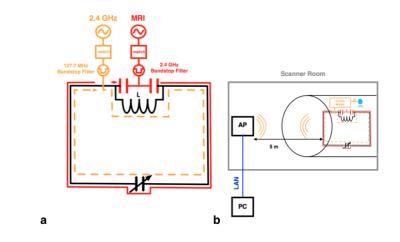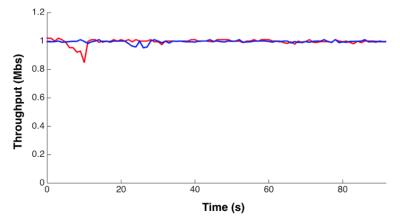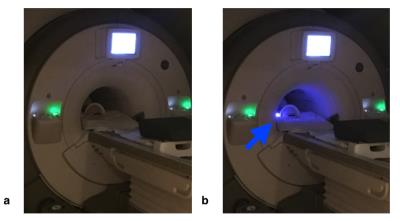4430
WiFi-enabled RF Coil for Simultaneous MR Image Acquisition and Wireless Communication1Brain Imaging and Analysis Center, Duke University, Durham, NC, United States
Synopsis
Implementation of wireless communications in an MRI scanner will reduce the complexity of the scanner by decreasing the number of wired connections and connectors. To enable wireless communication in the scanner, a new RF coil design is proposed which allows RF currents at the Larmor and wireless data frequencies to flow on the same coil element, thus enabling simultaneous MRI image acquisition and wireless data transfer with the same coil.
Introduction
Data transfer between 1) the MRI scanner or peripheral systems (e.g., sensors) located inside the scanner room and 2) the MRI console or auxiliary computers located outside the scanner room is fundamental to its operation. For example, data is transferred: to acquire MRI data, to obtain information from sensors for physiological monitoring (i.e. heartbeat and breathing), from a camera for motion tracking1, or from NMR probes for far field monitoring2, to present visual, auditory, or somatosensory stimuli to, or record responses from, subjects during functional MRI, to perform localized B0 shimming3, or to detune a radio-frequency (RF) receive coil array during pulse sequence RF transmit periods. Currently, all of these data are transferred through a network of wired connections, which can add significant complexity to the system.
Recently, in an effort to reduce the number of wired connections and connectors, prototype receive coil arrays have been proposed to perform wireless data transfer between the RF coil array and the scanner4,5,6. However, these solutions require additional dipole antennas4,5 or “sniffer” coils6 to be added onto the coil array and inside the scanner bore to enable wireless data transfer within the scanner. Here, we introduce a new RF coil design which can perform simultaneous MRI signal reception and wireless data transfer using the same RF coil.
Methods
In the proposed design, an RF coil is modified by implementing two RF-isolated ports to enable RF currents at the Larmor and wireless data transmission frequencies to flow on the same coil simultaneously without impacting image quality. To demonstrate the feasibility of this new design, a coil was modified to perform simultaneous MRI image acquisition at 3T and wireless data transmission at 2.4 GHz (WiFi). Specifically, a WiFi-enabled RF coil was created by adding a high-impedance 2.4 GHz band-stop filter between the coil and the MRI transmission line to prevent 2.4 GHz signal loss to the MRI port. Likewise, a 127.7 MHz band-stop filter was placed between the coil and the WiFi transmission line to maintain the MRI signal-to-noise ratio (SNR) (Fig 1a). A readily available 802.11b/g WiFI transceiver with on-board general purpose input output (GPIO) connections was used to perform wireless data transmission between the coil and a 2.4 GHz access point (AP) placed inside the scanner room (Fig. 1b).
Two proof-of-concept experiments were performed on a 3T scanner. In the first experiment, gradient-echo (GRE) and fast spin-echo (FSE) images of a water phantom and a healthy volunteer’s hand were acquired in three conditions: 1) with the unmodified RF coil, 2) with the WiFi-enabled RF coil, but with no wireless data transmission, and 3) with the WiFi-enabled RF coil and with simultaneous wireless data transmission.
To quantify the wireless data transfer of the system, a data stream was produced by sending 1.1 kilobyte data packets from the RF coil to the AP every 2 ms. The data packet error rate (PER) and throughput were monitored via a wired AP connection to assess the data transfer before and during the image acquisitions. In the second experiment, a blue light emitting diode (LED) attached to the WiFI module GPIO was activated during the scan to demonstrate the ability to remotely control an on-board system via wireless data transfer from the AP to the coil.
Results
Fig. 2 shows that in-vivo FSE images acquired before and during data transmission were not affected by wireless communication. The average SNR in the phantom calculated from the GRE images acquired with the unmodified coil, with WiFI integration but no data transmission, and with WiFI data transmission was 110.3, 109.5, and 110.4, respectively.
Fig. 3 shows that the data throughput was similar both before and during the GRE sequence. The measured PER was 0.9% and 0.5%, respectively, which is comparable to bench-top measurements between the AP and the external antenna provided with the module performed at a similar distance.
Fig. 4 shows the ability to remotely control an on-board system (LED) during MR image acquisition with the WiFI-enabled RF coil.
Discussion and Conclusion
These proof-of-concept experiments show that an RF coil can be used to perform simultaneous MR image acquisition and wireless data transmission with no degradation in image quality or data throughput. This novel design requires no additional coils and minimal additional circuitry to enable wireless communication and I/O. In general, this design can be expanded to use multiple RF coil elements of an RF coil array for wireless communication, which will facilitate high-throughput MRI image data transfer and enable remote control of monitors and sensors within the scanner bore.Acknowledgements
The authors thank Fraser Robb of GE healthcare for ongoing support. This work was in part supported by NIH grants R21 EB018951 and R24 MH106048.References
1. Maclaren J et al. MRM 2013:69:621-36
2. Barmet C et al. MRM 2008;60:187-197
3. Truong TK et al. Neuroimage 2014;103:235-240
4. Aggarwal, K et al. Proc ISMRM 2016;24:545
5. Aggarwal, K et al. IEEE Trans Med Imaging 2016;DOI: 10.1109/TMI.2016.2622251
6. Bulumulla, S.B et al. MRI 2015;33:351-357
Figures



